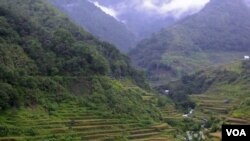CORDILLERA, PHILIPPINES —
An estimated 80 percent of Asia’s rivers are considered “sick,” meaning they suffer from pollution and the uncoordinated development of water resources. As conservationists rethink strategies to save rivers, young researchers in Manila are finding promise in an age-old watershed preservation approach.
The Ifugaos of the Cordillera region in northern Philippines are known as the builders of the area’s UNESCO heritage rice-terraces. Such mountainside farms have survived for more than 900 years, in part because locals have maintained nearby forests and protected the watersheds that sustain their fields.
In the lowlands, expanding populations and industrial growth have stressed rivers and water basins, despite master development plans designed by top engineers.
Asia Development Bank water expert Wouter Lincklaen Arriens says the old practices of local communities should play a bigger role in modern watershed management.
“It is the communities, it is the societies that have to come to grips with the shortages and excesses of water availability. So the resilience is really in the people and in the communities,” said Arriens.
Students such as Jae Woo Jang, a seventh grader at an international school in Manila, are teaming up with researchers like Scott Platt-Salcedo in the search for solutions to the Philippines’ water woes.
Jang says the key to the success of the Ifugaos appears to be their commitment to biodiversity; the variety of plants and other living things that make forests healthy and in turn store more water.
"People did not have to be taught that biodiversity was important. They realized that the healthy forest was built by their need to plant diverse plants. For example, they have planted 171 different tree species… among which 121 are used for specific purposes," said Jang.
Ifugao elder and farmer Jose Pinay-an of the Cordillera’s Hungduan town says the forest preservation techniques used today were passed down from ancestors.
"We have water because our parents taught us that when we cut some trees, we should plant more than what we cut. So that's our practice," said Pinay-an.
However, the old practices that have proved successful for so long are struggling to connect with the next generation of Ifugaos, who are increasingly leaving the fields behind to pursue jobs in the lowlands.
It’s a bittersweet moment for the community; even as their conservation techniques gain recognition amongst researchers, the Ifugaos are struggling to pass them on to their own children.
The Ifugaos of the Cordillera region in northern Philippines are known as the builders of the area’s UNESCO heritage rice-terraces. Such mountainside farms have survived for more than 900 years, in part because locals have maintained nearby forests and protected the watersheds that sustain their fields.
In the lowlands, expanding populations and industrial growth have stressed rivers and water basins, despite master development plans designed by top engineers.
Asia Development Bank water expert Wouter Lincklaen Arriens says the old practices of local communities should play a bigger role in modern watershed management.
“It is the communities, it is the societies that have to come to grips with the shortages and excesses of water availability. So the resilience is really in the people and in the communities,” said Arriens.
Students such as Jae Woo Jang, a seventh grader at an international school in Manila, are teaming up with researchers like Scott Platt-Salcedo in the search for solutions to the Philippines’ water woes.
Jang says the key to the success of the Ifugaos appears to be their commitment to biodiversity; the variety of plants and other living things that make forests healthy and in turn store more water.
"People did not have to be taught that biodiversity was important. They realized that the healthy forest was built by their need to plant diverse plants. For example, they have planted 171 different tree species… among which 121 are used for specific purposes," said Jang.
Ifugao elder and farmer Jose Pinay-an of the Cordillera’s Hungduan town says the forest preservation techniques used today were passed down from ancestors.
"We have water because our parents taught us that when we cut some trees, we should plant more than what we cut. So that's our practice," said Pinay-an.
However, the old practices that have proved successful for so long are struggling to connect with the next generation of Ifugaos, who are increasingly leaving the fields behind to pursue jobs in the lowlands.
It’s a bittersweet moment for the community; even as their conservation techniques gain recognition amongst researchers, the Ifugaos are struggling to pass them on to their own children.







